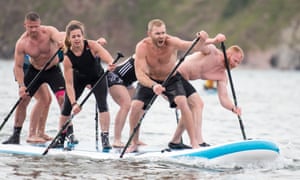You probably didn’t notice but at the end of this summer, on the sandy beach of Bantham, near Kingsbridge in South Devon, 960 men and women gathered for a gruesome battle. For an entire weekend, this stretch of English coastline saw teams of furious men and women dashing across hilly trails, hoisting atlas stones and lugging a 240kg sandworm, in both blistering heat and torrential rain.
This wasn’t a Viking re-enactment (too much compression gear for that), but an annual competitive fitness event called Tribal Clash, the appetite for which is almost as strong as the participants’ mettle. Since its launch in 2013, Tribal Clash has more than doubled in size, from 100 teams of four to 160 teams of six, and has also begun holding a second annual event in Portugal.
It is almost certainly inspired by the growth of CrossFit, the high-intensity, competitive strength and conditioning programme that has captured the heart and lungs of hundreds of thousands of people around the world. In 2016, CrossFit was reported to have 13,000 gyms in more than 120 countries – even more than the 12,500 Starbucks in the US.
Yet while competitions such as Battle of the Beasts and the CrossFit Games, with their huge prize money, have become the playground of elite athletes and bodybuilders, the new-wave competitive events such as Tribal Clash, Wild West Fitness, the Superhuman Throwdown and nationwide gym chain Fitness First’s own competition, Fit Brit, aim to be more inclusive.
“There are no qualifying events or age divisions in Tribal Clash,” says one of the event organisers, Heidi Clover. “You need a base level of fitness but some teams just enter for fun, while, for others, this is like their Olympics – they train all year for it. But it’s great for beginners because there are no technical moves, such as Olympic weightlifting.”

“It hurts, though,” she adds. “It’s hard, and we’re always looking for ways to enhance the athlete experience. This year, we staged the biggest ever stand-up-paddleboard race and we added a little twist to our trail run in the form of a 150m uphill sprint section where times were scored separately.”
Unsurprisingly, people get injured doing these events. Beginners are especially vulnerable because their bodies aren’t conditioned for it, says former CrossFit coach Stretch Rayner: “Connective tissue strength is critical, for example, and that can take 230 days to build. Muscle strength can take 90 days and, for many athletes, it takes years of hard work and dedication to reach a high level.”
The brutality of a weekend spent doing a range of physical activity under very competitive conditions is no deterrent. Spots in Tribal Clash cost £110 a head – excluding accommodation and travel – and are snapped up within 24 hours of going on sale.
So what is the appeal? Magdalena Rotsztejn, a 30-year-old Tribal Clash finisher who works as a delivery manager for a technology firm, says: “For me, competing means finding my limits and going beyond them. There are so many moments in an event when the adrenaline kicks in and I surprise myself with what I’m capable of. I feel independent, powerful, as if I can achieve anything, and then that carries over into the rest of my life.”
Renata O’Donnell, 41, works for a small investment bank in London and has competed in Tribal Clash for the past two years. “I love that it takes the vanity out of fitness and gives it more purpose,” she says. “It has helped me give my training more focus and stick to a healthy lifestyle, but, more than that, I love the team aspect. It’s about communicating and working together as a unit, because you’re only as strong as your weakest link.”

O’Donnell describes the final race, a log-carrying contest, at the 2016 event: “There was a team with a girl who had sprained her ankle and the task was to run around the arena with the log, go out into the sea and swim with it. All six members had to be involved and have their hands on the log at all times. Rather than drop out, this team put the injured girl on the log and ran the course with her on it. She was able to do the swimming part, as it didn’t hurt her ankle. Yes, they came last, but it was tough as nails and the most brilliant display of teamwork I have seen in a long time.”
So is competitive fitness inspirational, motivational and perhaps also educational? CrossFit coach and competitor Alexis Rufus, 38, certainly thinks so. She was part of the winning team at the competitive fitness European Championships this year, but insists that regardless of one’s competitive level, the personal discoveries are limitless: “Most people ask themselves the same questions when entering a fitness competition: am I really good enough; will there be lots of people watching and judging me? But do you really know how your body works under pressure? Can you truly know what will take place? Physically, I’ve found the competitions seriously tough, but the greatest challenge by far has been mental. Sometimes what I have to put myself through is like voluntarily walking through fire.”
So why do it? “It’s simple,” she says. “I love competing. I love testing what I am capable of doing and constantly pushing those limits. I actually enjoy walking through the fire and seeing what comes out the other side. Because if I didn’t try then I would never know and the only real failure is not trying.”
• This article was amended on 3 October 2017. The original erroneously stated that Battle of the Beasts is a CrossFit competition. This has been corrected.
Source: Read Full Article
